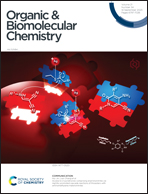Enantioselective synthesis of 3-hydroxy- and 3-amino-3-alkynyl-2-oxindoles by the dimethylzinc-mediated addition of terminal alkynes to isatins and isatin-derived ketimines†
Abstract
A common protocol for enantioselective alkynylation of isatins and isatin-derived ketimines using terminal alkynes and Me2Zn in the presence of a catalytic amount of a chiral perhydro-1,3-benzoxazine with moderate to excellent enantioselectivity under mild reaction conditions is described. The additions to ketimines present a novel approach to chiral amines being derivatives of oxindoles. The reaction is broad in scope with respect to aryl- and alkyl-substituted terminal alkynes and isatin derivatives. In isatins, the alkynylation occurs at the Si face of the carbonyl group, whereas in the ketimine derivatives it occurs at the Re face of the imine.



 Please wait while we load your content...
Please wait while we load your content...